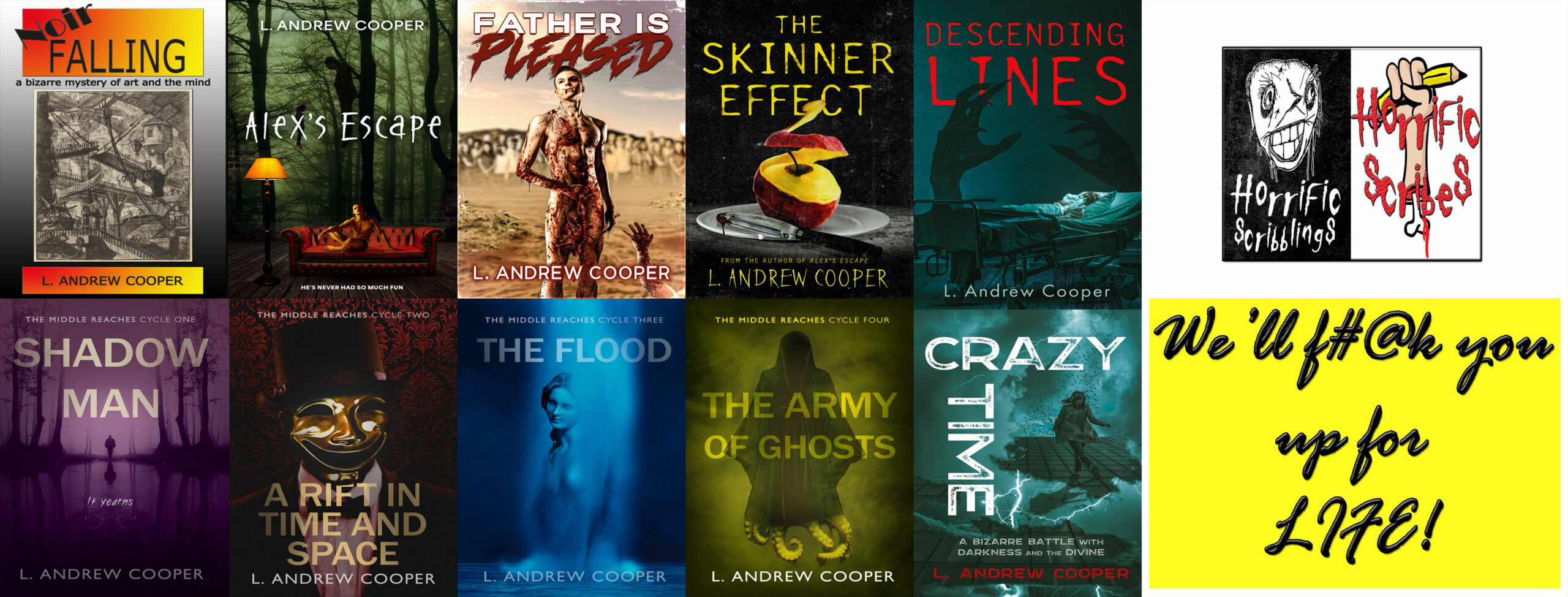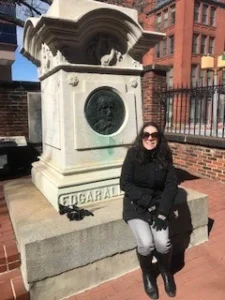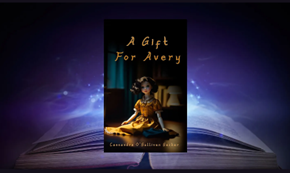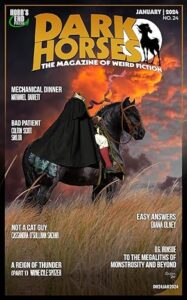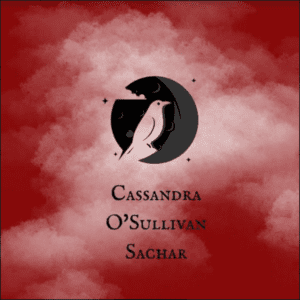Interview with Author Cassandra O’Sullivan Sachar: Darkness There but Something More, Keeper of Corpses and Other Dark Tales, and No More Haunted Dolls (2024)
Superb writer and English professor with a penchant for horror Cassandra O’Sullivan Sachar discusses her new novel Darkness There but Something More as well as her forthcoming collection of short stories Keeper of Corpses and Other Dark Tales and her edited volume of horror scholarship No More Haunted Dolls.
Darkness There but Something More: A Novel
After the loss of her baby and subsequent divorce, Edgar Allan Poe scholar Marissa Owens leaves her tenured job as an English professor for a fresh start at her alma mater, Blackthorn University. As she begins to feel like herself again, one of her favorite students goes missing.
Then, the police find the body.
The investigation descends upon the campus, and familiar clues begin to surface. This triggers a disturbing memory from Marissa’s own dark past at Blackthorn—one she has attempted to keep buried.
Keeper of Corpses and Other Dark Tales
Life runs amuck in Blackthorn, Pennsylvania, and residents are rarely safe from the hands—or claws—of nefarious forces. From accidents to cursed objects, trouble is always afoot.
A woman prepares the bodies of nursing home residents for the funeral home while plotting revenge on her son’s killer. A college student has visions of people’s futures, but no one heeds her warnings. On a trip to Chile, a couple receives a personal wine tour for a price they weren’t expecting to pay: their lives. During her honeymoon to Greece, a newlywed discovers she hasn’t fully escaped her abusive mother. A lawn care provider thinks he has a bad mosquito bite, but it is something far, far worse. After covering up his dog’s accidental killing of his neighbor’s cat, a computer programmer runs into larger problems to bury. Since he was expelled from high school for his behavior, a troublemaker transfers to an academy where classes take place during the night and the teachers are known for their bite. A psychology professor must revisit a mistake from early in her career. Two sisters and their husbands sign up for a zombie-themed 5K, looking for some fun, but they end up running for their lives! A man suspects his girlfriend’s cat is the reincarnation of her husband. And more! These tales run the gamut of the horror genre.
No More Haunted Dolls: Horror Fiction that Transcends the Tropes
This is a multi-author work united by the common theme of critical analysis of the use of horror tropes in literature, film, and even video games. Tackling issues dealing with gender, race, sexuality, social class, religion, politics, disability, and more in horror, the authors are horror scholars hailing from varied backgrounds and areas of specialty. This book may be used as a resource for classes that study horror or simply as entertainment for horror fans; readers will consider diverse perspectives on the tropes themselves as well as their representation in specific works.
The Interview
1. Darkness Who? Your bio (below) reveals a few details about your life as an English professor with a scholarly background in horror fiction, and the protagonist of Darkness There but Something More, Marissa,is… similar. The similarity seems to invite (auto)biographical interpretation… but clever authors are often playful with such invitations, and you are a clever author. As characters in your book know, readers wonder endlessly about Edgar Allan Poe’s life… do you want readers wondering about you if/when they perceive the biographical similarities? Why or why not? Avoiding spoilers, to what extent is the book based on your actual experiences?
COS: I know that people who know me will likely see some resemblances, but I wouldn’t want readers speculating about me since this is a work of fiction! Marissa shares certain characteristics with me beyond the career–for example, she is petite, enjoys Starbucks, and pledged a sorority in college, and I have drawn from my own experiences when conveying Marissa’s worries about her relationships with others and her fears of not fitting in. However, the events of the novel, thankfully, do not reflect my life in any meaningful way. What’s interesting to me is how diametrically opposed Marissa and I are in one particular aspect. While Marissa yearned for a baby and endured years of IVF struggles and miscarriages, I never planned to have children, but my unplanned pregnancy and ensuing motherhood in college changed my life trajectory. Somehow, though, when snippets of this story began to flood my mind, one of the first things I learned about Marissa was what she had lost and how it affected her. Another important distinction is our family backgrounds. I am fortunate to have grown up with love from parents who supported my goals, unlike Marissa. While I warned my mom that she was reading a work of fiction and that she needed to keep in mind that Marissa was not me, I wasn’t worried that she would think I was characterizing her or my dad since they are completely different from Marissa’s parents.
2. Darkness Where? Darkness There but Something More seems to fit in the tradition of what some, at least in academic circles, have called “Academic Gothic,” mostly referring to scholastic settings and Greek (or otherwise selective) society involvement but also netting creepy campus relationships. The tradition includes famous stories such as Algernon Blackwood’s “Secret Worship” (1908), films like Sorority Row (2009), and the TV show Scream Queens (2015). Were you reflecting on this tradition as you wrote your novel? How would you situate your book within it? What’s Gothic and/or scary about academic places and experiences, both in general and in your work specifically?
COS: As a lover of Academic Gothic, I wanted to provide readers with a feeling of eeriness through the references to Poe and an autumnal campus setting with its elderly buildings and buried secrets. Other works of this genre often depict elite, privileged characters, and I chose not to. Many of the students at Blackthorn University, like Marissa herself, are from lower socioeconomic backgrounds. Unlike the regal sorority mansion depicted in Scream Queens, Marissa pledged in a derelict rowhome, and I think this adds a different flavor to my novel, along with an element of grittiness. Despite the difference in glamour, the girls are just as willing to endure whatever it takes to become part of the sisterhood, and this can be extremely dangerous. It’s frightening to think about this underground side of college life, the brutal hazing continuing to take place in basements despite universities’ best intentions. While the dark academia aesthetic often focuses on dusty libraries and dimly lit stairwells, which can be intriguing and even romantic, my personal interpretation includes these harsher, uglier elements as well.
3. Return to the Repressed. Since the description of your novel mentions Marissa’s “dark past at Blackthorn,” readers might guess that going back there for a “fresh start” isn’t as bright an idea as, perhaps, going somewhere fresher than a place where Marissa doesn’t have a dark past. Nevertheless, characters in horror stories often seem to return to places perhaps better left in the past. What about Marissa’s psychology—consciously and unconsciously—justifies her decision to return? Fleeing tremendous grief and landing in more, Marissa is certainly traumatized. How do you represent the evolution of her mental state?
COS: Despite physically leaving Blackthorn as a young woman, Marissa never truly left it in the past. I believe she’s carried her guilt and has used it as justification for her unhappiness and misfortune. On the surface, Marissa returns to Blackthorn as an escape from the losses of her baby and marriage. When Candace, her friend and former professor, encourages her to apply for a position, it seems like a way to move on. It’s a convenient move to make since her connection to Candace is one of her only surviving relationships, so there’s familiarity and comfort at Blackthorn despite what happened in her youth. I believe Marissa understands on some level that she has unfinished business at Blackthorn and that she must finally face what happened there. The title of the novel, an obvious reference to Poe’s “The Raven,” signals that there’s more for Marissa in store than the darkness that has shrouded her.
4. Categories I. Since we both write horror and write about horror, I hope we share an interest in the meanings of genre (and marketing) classifications. Once again looking at your bio (below), I see Darkness There but Something More classified as “dark suspense” while the story collection Keeper of Corpses and Other Dark Tales is “horror.” What is dark suspense, and how does it differ from horror? Does the difference have anything to do with the old distinction between “female” or terror-based Gothic and “male” or horror-based Gothic? I recently interviewed a filmmaker, Rakefet Abergel, whose short film “Still” is about a miscarriage, a distinctly female horror (at least in the film) but a horror all the same. Do you think your novel of dark suspense deals in distinctly female terrors and/or horrors? Why or why not?
COS: To me, “dark suspense” suggests a mystery with horror elements, while “horror” focuses more on instilling fear, often through gruesome descriptions. I don’t know how much gender comes into the distinction, but I will say that Darkness There but Something More feels far more woman-centric in nature than my short story collection due to the focus on sisterhood as well as on pregnancy. While a fraternity could easily be substituted for the sorority, pregnancy through a male gaze is far different. I think that some of what Marissa endures–for example, heartbreak, betrayal, and imposter syndrome–transcend gender and are simply universal human experiences to which readers will be able to relate.
5. Categories II. Keeper of Corpses and Other Dark Tales is not only horror, but it “run[s] the gamut of the horror genre.” Since the gamut of horror has grown very wide over the centuries, I must admit I have trouble imagining a single collection making that run. What’s really involved in your run (feel free to show off your stories’ diversity with examples)? Was demonstrating the genre’s diversity one of your goals? If so, why? If not, how did the collection end up being so diverse? How do you expect readers to respond to the variety of tales? Which tale is most difficult to classify? Why?
COS: There are certainly sub-genres absent from my collection, but it covers a lot of territory: cursed objects, vengeful killers, zombies, ghosts, and more. From my own take on classic tropes (“A Gift for Avery” with a haunted doll) to horror comedy (“I’ll Sleep Tomorrow” with an overworked professor who ends up sacrificing far too much to achieve tenure) and even body horror (“Itch” with a guy who has a condition far worse than a mosquito bite), my hope is that there’s something for every horror lover.
I didn’t set out to cover any specific ground when I started writing short horror fiction, especially since I wrote the initial version of one story as an assignment in seventh grade, but I ended up with 27 tales, so it’s natural that they aren’t all alike. I wrote some for specific submission calls and others simply because I had a fun idea and wanted to try it. What I love about writing and reading short stories is the short-term commitment and how I can explore different characters and settings in a low-risk scenario. For example, I don’t know that I’d want to dwell in a world where zombies exist for an extended time, or that I’d have the endurance to extend the suspension of disbelief, but I had a lot of fun with my 3,800-word story “Run!”
Out of everything, the story that’s hardest to classify and almost wasn’t included due to its tenuous inclusion within horror is “Not a Cat Guy.” Jason is convinced his girlfriend’s cat is the reincarnation of her dead husband. Written in second person, it’s not scary and is more comic in nature, with the narrator coming across as rather buffoonish. But that’s something I hope readers will enjoy about this collection–the comic relief breaking up some of the darker, more sinister tales.
6. “Pet lover and…” A line from your Amazon bio missing from the bio here identifies you as a pet lover. At least two stories in your collection, however, put animals at the center of the horror. What inspires you to include animals in your horrific scenarios? How do you think other pet lovers will react to these stories (violence involving animals is on a lot of people’s “trigger” lists)?
COS: I’ve had pets for almost my whole life, so it’s very natural for me to include them in my writing, whether horror or not. As a writer, I’d always rather kill off a human than an animal since it upsets me as a reader, especially when a killer is threatening their intended victim by taking the life of their beloved pet. I haven’t been able to entirely avoid animal deaths, though, in my own writing. Two stories in my collection involve the deaths of cats, but neither one dies at the hands of a human, and both deaths occur off-page. Even my depraved killers draw the line and stick to killing people. Unlike my character Jason, I am very much a cat person, so I hope I have handled the deaths with respect.
7. “… world traveler.” That’s the rest of the aforementioned line from your Amazon bio. Characters in your stories travel to Chile and Greece, and horrors either find them or follow them. As you know, early Gothic horror and travel narratives are closely related (even Poe’s only novel is a kind of travel narrative). How does travel affect the characters in your stories? Assuming readers aren’t actually from the locales you describe, how do you think the unfamiliar (or at least less familiar) settings affect their relationships with the characters and with the stories more generally? Brief examples from your tales are most welcome!
COS: During the semester, I’m so busy with the demands of my job (especially grading papers since I teach all writing classes) that I rarely even venture out of town. Therefore, after I’ve submitted my grades every semester, I’m ready for an adventure! My husband and I have learned how to snag great flight deals and travel on a budget, and we love exploring different landscapes and cultures. I think of my short stories almost as love letters (yet with horror twists, simply because I love writing horror) to the places I’ve visited. I hope readers enjoy traversing these unfamiliar territories with my characters, who are generally enjoying their trips until the horror finds them. Not everyone is able to travel to a Chilean winery, which is why I’ve researched the history of winemaking in the region and described the beautiful countryside in “Budget Wine Tour.” As much as my own real-life travels have impacted my writing, verisimilitude is paramount to me, so I always end up taking great pains to include details that will give the reader a realistic window into a new locale. By including true-to-life details, I am attempting to draw the reader into a suspension of disbelief that will better prepare them for the more fantastical parts of the story.
8. Transcendent Horror. The non-fiction book No More Haunted Dolls: Horror Fiction that Transcends the Tropes that you’ve edited promises to be a horror resource that covers a lot of ground. What are examples of the major tropes the book examines, tropes that appear across literature, film, and video games? What works stand out for their uses of these tropes? Why? Is the horror genre even recognizable without its tropes? How does a work of horror transcend tropes? Can you provide one or two examples of trope-transcending horror?
COS: Some of the many tropes the scholars explore in the volume include the masked killer, cannibalism, vampirism, and possession. Two of the most heavily-referenced films are the Scream and Halloween franchises, while Dracula and Frankenstein stand out for books. While very different from each other, all of these works are beloved due to the iconic and often multifaceted nature of the villains and/or final girls.
I believe that tropes are necessary in horror; just as we need a relationship to focus on in a romance, there are expectations that must be met to fit the genre. I personally love horror tropes–give me a creepy, possibly evil child or a butt-kicking final girl any day. What I dislike is when a writer has nothing new to offer and the trope is the whole story. I’m always looking for fresh interpretations of a trope rather than a storyline that merely recycles what has been done countless times before. Writers can transcend tropes through layering elements that are fresh and unexpected.
A great example of a work that transcends tropes is Silvia Moreno-Garcia’s Mexican Gothic. The author takes the crumbling mansion trope and adds something new by placing the setting in Mexico rather than Europe or America. Additionally, she tackles issues dealing with race and gender discrimination. The novel is not merely a haunted house book but one with carefully drawn characters and a well-executed plot.
9. Seeing the Future. One of the stories in Keeper of Corpses and Other Dark Tales is about a, um, Cassandra figure who sees the future and isn’t believed. The pun possibility aside, since you know horror history, and you’re participating in its present, I’m going to ask you to prognosticate: what is horror’s future? If horror writers manage to transcend, or at least transform, the tropes, what might horror’s next generation(s) look like?
COS: But if I tell you the future, you’ll never believe me! My prediction is that horror will continue to grow but will split up into more sub-genres, perhaps through the more frequent labeling of trigger warnings. One cannot paint horror with a broad brush; it is far too broad as a classification, especially since readers and writers have vastly different tastes. During my time in the horror community, I’ve become aware of controversies and biases against certain sub-genres, particularly splatterpunk. In addition to lambasting the work itself, critics have made vile accusations about the writers. It’s not my personal preference; I will forever be scarred by the rat scene in Brett Easton Ellis’s American Psycho. Still, I hate seeing fellow members of the horror community stigmatized. We can support each other as horror writers while choosing to read work that aligns with our own interests. There’s so much diversity in what writers are producing, and I think there’s an audience for it–the trick is for readers to understand what types of horror they want (and, in some cases, don’t want) to read. I would never write a bad review of a work or make comments against an author if I’m simply the wrong audience for that sub-genre.
In terms of the next generation of horror, I think we’ll continue seeing interesting combinations of layered horror tropes and genre blending to give us truly unique tales.
10. Access! How can readers learn more about you and your works (please provide any links you want to share)?
COS: https://cassandraosullivansachar.com/; @cosachar (Instagam)
About the Author
Cassandra O’Sullivan Sachar is a writer and associate professor of English at Bloomsburg University of Pennsylvania, where she teaches courses in creative writing, first-year composition, and composition theory. A former English teacher in Delaware public schools, she received her Doctorate of Education with a Literacy Specialization from the University of Delaware and her M.F.A. in Creative Writing with a focus on horror fiction from Wilkes University.
Dr. Sachar is the author of the dark suspense novel Darkness There but Something More (published by Wicked House Publishing in March 2024) and the short horror story collection Keeper of Corpses and Other Dark Tales (forthcoming from Velox Books in 2024). Furthermore, she is the editor of a multi-author volume on horror scholarship, No More Haunted Dolls: Horror Fiction that Transcends the Tropes, forthcoming from Vernon Press in 2024.
A member of the Horror Writers Association, she has placed horror stories and essays in numerous publications including The Horror Zine, HorrorAddicts.net, The Angry Gable, The Chamber Magazine, and Tales from the Moonlit Path. She has chaired panels on and presented horror scholarship at the Northeast Modern Language Association (NeMLA) Convention and the Ann Radcliffe Academic Conference. She has additionally served as the fiction editor for River & South Review and will soon begin as the creative prose editor of Pennsylvania English. Her research studies and practitioner articles have appeared in diverse educational publications.
HORRIFIC SCRIBES EXHIBIT ONE: Return to “Squish“
Proceed to the next Gallery One: Traps attraction, “The Revenge Room“
